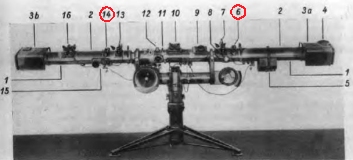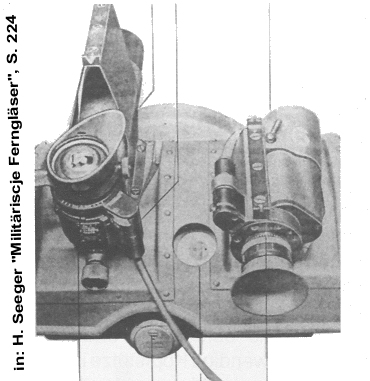Carl Zeiss Su.-F. 6x30
|
Dieses monokulare Sucher-Fernrohr (Su.-F.) 6x30 wurde am 4 Meter Raumbild-Entfernungsmessern - "Em 4m R(H)" - zum Anvisieren benutzt. Es hat einen Orange-Gelbfilter, der sich mit einem Hebel am Objektivtubus vor die Objektivlinse schwenken lässt. In den ersten Bildern sieht man die Montageschiene, eine Schraubklemmvorrichtung, das Beleuchtungsfenster für die Strichplatte (Zielkreis), eine Zielvorrichtung (Kimme und Korn) und die Beschriftung. Die Art und Position der Montage am EM sieht man auf dieser Webseite (drittletztes Foto) und weiter unten. Die Monokulare haben i.d.R. zwei Beschriftungsschildchen am Objektivtubus, eines mit der Typenbezeichnung zum Entfernungsmesser, wobei "R" für Raumbild und, wenn vorhanden, "H" für Höhenmessung steht. Eine weitere Nummer wie "34", "36" oder "40" bezieht sich auf das Jahr der ersten Herausgabe des Entfernungsmessers (s. Link unten). Das untere Schild trägt das Zeiss-Linsenlogo und eine Seriennummer, die beim 3. gezeigten Exemplar nicht mehr erkennbar ist. |
This monocular direction finder scope (Su.-F.) 6x30 was mounted on 4 meter stereoscopic rangefinders "Em 4m R(H) 36", "34" or "40" used for aiming and aligning. It was supplied with an amber filter which could be swung in front of the objective lens by turning a lever at the objective tube. In the first few pictures you can see a mounting rail, screw and clamp device, the aiming sight (notch and bead) and the labels. See this website (third but last pics) and pictures below showing how the finder scope is attached to the rangefinder. The monoculars usually came with two labelling plates on the objective tube. One carried the type designation of the rangefinder, the "R" stood for "Raumbildmesser" (= stereoscopic rangefinder), and if present, the "H" for "Höhenmesser" (= height finder). A further number like 34, 36 or 40 refers to the year when the rangefinder model was introduced (see link below). The second plate was marked with the Zeiss lens logo and a serial number. This serial number is not visible on the third model (second but last picture). |
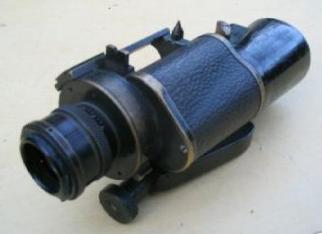
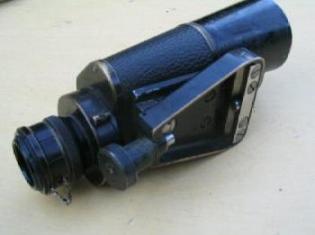
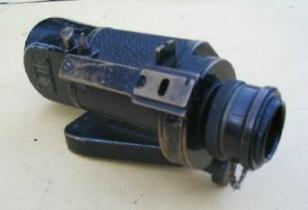
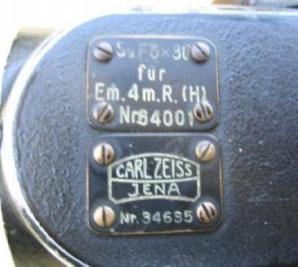
| Das 2. Modell mit Nr. 16 (mit unbekannter Abkürzung "f.A.O zum 4U") ist mit einer weißen "1" sowie "T" gekennzeichnet. Während die 1 vermutlich für das 1. Monokular der zwei am Em befindlichen steht, bedeutet das "T", dass das Monokular mit dem T-Belag vergütet ist (grünlich-gelber bis blauer Schimmer). Man erkennt die abnehmbare durch eine Kette gesicherte Weichgummiaugenmuschel. Dies ist mit dem Zeiss Punktualzeichen (verschlungenes CZ) versehen. Die Dioptrienskala ist mit + und - und evtl. einst phosphorisierenden tropfenförmigen Markierungen gekennzeichnet. Am Sockel des 6x30 befindet sich eine Produktionsnummer "131606" (das 3. Modell hat die Produktionsnummer ("81111"). Das Okular hat eine Strichplatte mit einem zentralen Kreis zum genauen Anvisieren. Welche Funktion der dickere Ring zwischen Okular und Gehäuse hatte, lässt sich nur vermuten: evtl. für eine Beleuchtungseinheit oder zum Drehen bzw. Justieren der Strichplatte. | The second model with number 16 (the meaning for the abbreviation "F.A.O zum 4U" is unknown) is inscribed with a white 1 and a T. The "1" probably stands for the piece number of the two monoculars attached to the rangefinder, and the "T" says that this monocular has coated optic (greenish-yellow and blue tint). The detachable soft rubber eyecup is in place and its mounting ring is secured with a little chain. The rubber is marked with the interwoven "CZ" letters, the Zeiss "Punktual" emblem. The dioptre scale is inscribed with plus and minus and several tear drop shaped markings which probably once were fluorescing due to phosphor inlays. The base has a stamped in production number ("81111"). The eyepiece has a built-in reticle with a central circle for a better targeting. The function of the thick ring part between the ocular part and the housing is uncertain, maybe for attaching an illumination unit or turning and adjusting the reticle. |
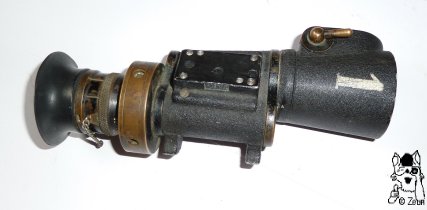
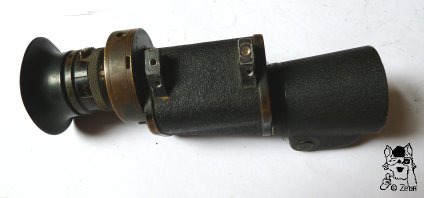
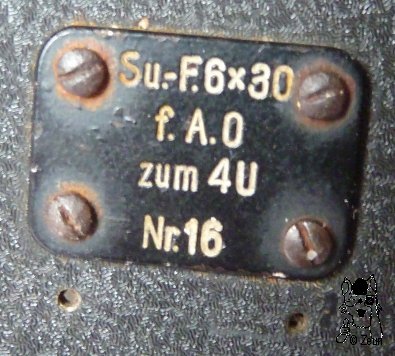
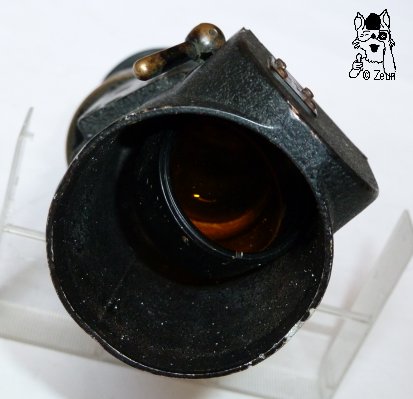
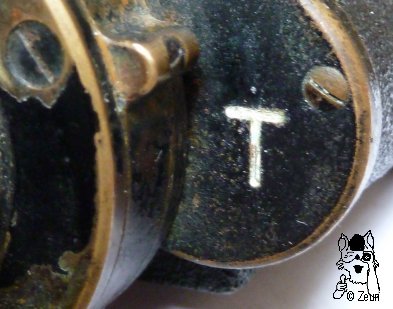
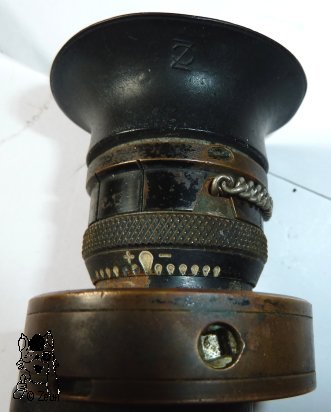
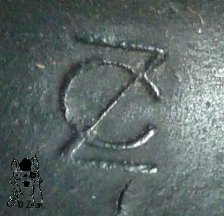
| Das 3. hier gezeigte Exemplar (Nr. 1440) ist noch ohne Vergütung. Die gezeigte Beschriftung ist direkt am Deckel angebracht und trägt die Hoheitszeichen aus dem 3. Reich und gehörte wohl zu einem 3 Meter (?) Raumbild-Entfernungsmesser. Ähnlich ist ein Richtmann-Fernrohr mit "Rm.F. 6x30 zum 3R" und "Nr. 21" beschriftet. Es hat eine Strichplatte mit einem Kreis und darin ein Fadenkreuz. Ein Exemplar aus dem 2. Weltkrieg ist mit dem Herstellercode blc für Zeiss gekennzeichnet. |
The 3rd model shown (Nr. 1440) is without coating. The last picture shows another inscription on the cover plate of monocular used with a 3 (?) meter stereo image rangefinder, also marked with Third Reich insignia. Another similar model, a director telescope (director = Richtmann) is marked "Rm.F. 6x30 zum 3R" and "Nr. 21". It has a reticle with a circle and cross-hairs within the circle. A specimen from WWII. is marked with the maker's code blc for Zeiss. |
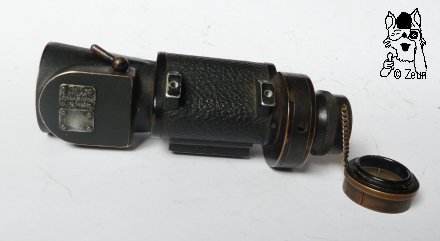
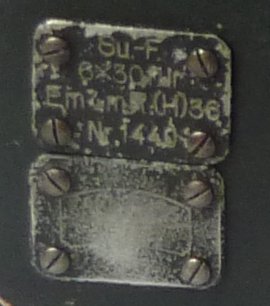
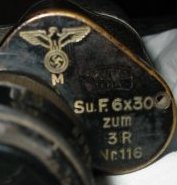
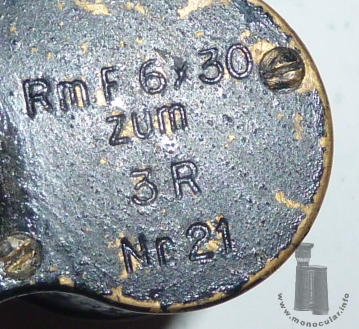
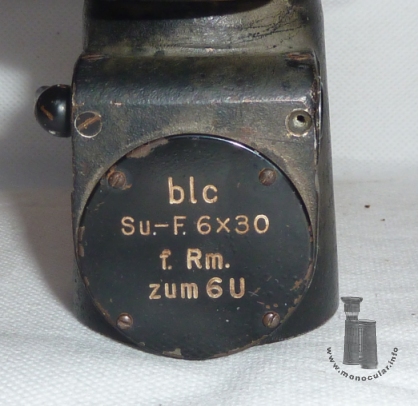
| Das Su.-F. 6x30 ist 190 bis 195mm lang, das Gehäuse oben 51x51mm und unten 52x59mm breit. Der Objektiv- und Filtertubus verbreitert sich von 42 auf 52mm im Durchmesser. Der dicke Ring am Okular ist 52mm, das Okularstück ca. 37mm und die Augenmuschel 57mm im Durchmesser. Das Gewicht liegt bei ca. 664g. | The "Su.-F. 6x30" is 190 to 195mm in length, the housing measures 51x51mm at its top and 52x59mm at its bottom. The objective and filter tube increases from 42mm to 52mm in diameter. The thick ring around the eyepiece is 52mm, the eyepiece itself ca. 37mm, and the eyecup 57mm in diameter. The monocular weighs about 664g. |
| Die folgenden Fotos zeigen die Montageposition am Em4. | The mounting position on the rangefinder "Em 4" is shown in the following pictures. |
| Es gab auch Lizenz- oder Exportmodelle des "Su.F. 6x30". Diese hatten am Objektivtubus eine Zeiss-Logo-Beschriftungsplatte und dort oder am Gehäuse ein Kennzeichnungsschild in der Sprache des Exportlandes (vgl. Seeger "Militärische Ferngläser", S. 224). Die hier abgebildeten Modelle wurden für die griechische Armee und durch MOM Budapest (Ungarn) geliefert. Das griechische Modell hat die Produktionsnummer 88495 an der Basis des Montagefußes. Alle Anbauteile außer der Originalaugenmuschel sind noch erhalten. Die Dioptrienskala ist bei Null und bei +/- jeweils mit "6" beschriftet. Die griechische Beschriftung entspricht ungefähr der deutschen. Als letztes ist "Nr. 3" entspricht weißer Ziffer oben auf dem Objektivtubus) vermerkt. |
There were also some licence or export models of the finder scope 6x30. These came with a label plate on the objective tube showing the Zeiss logo, and another designation plate in that place or on the housing written in the export country's language (cf. Seeger "Military Binoculars ....", p. 224). The models shown here were made for the Greek Army and by MOM in Budapest (Hungary). The Greek model has the production number 88495 on the base of the mounting rack. All accessory parts except for the original eyecup are still in place. The dioptre scale is marked at zero and with 6 at the + and - scales. The Greek inscriptions are nearly the same as the German ones. As a last data "Nr. 3" is given which corresponds with the white painted number on the top of the objective tube. |
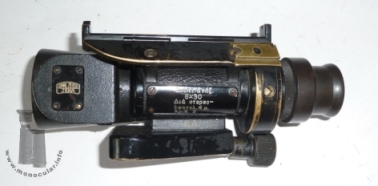
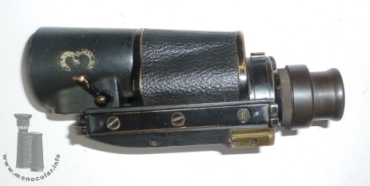
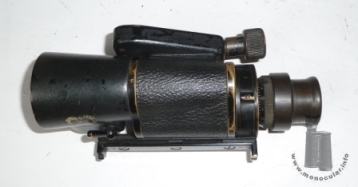
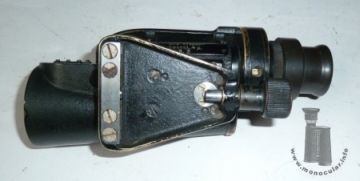
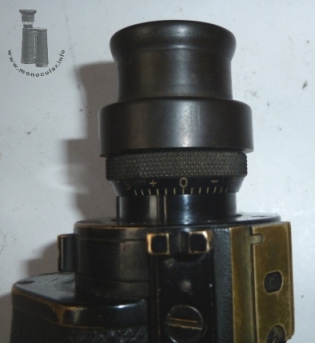
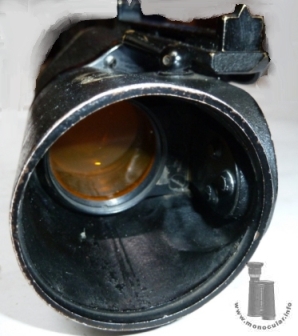
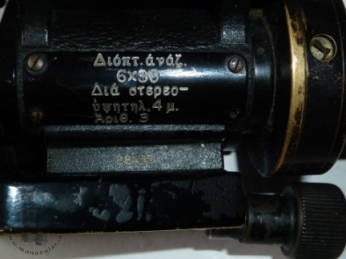
| Das grüne MOM Modell ist am Objektivtubus mit "Ke.t 6x30" (Kereso távcso = Sucherfernrohr), "4099 sz" (sorozatszám = Seriennummer) und unter dem MOM-Logo mit "Zeiss rendszer" (Zeiss System) gekennzeichnet. | The green MOM model is marked on the objective tube plates "Ke.t. 6x30" (Kereso távcso = finder scope), "4099 sz" (sorozatszám = serial number) and below the MOM logo with "Zeiss rendszer" (Zeiss system). |
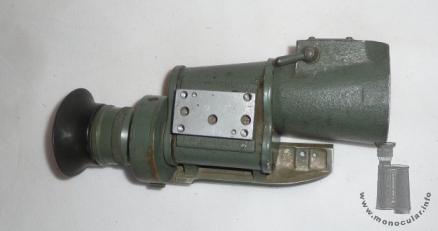
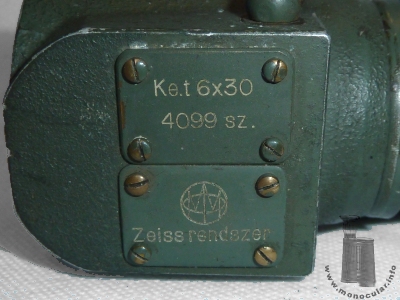
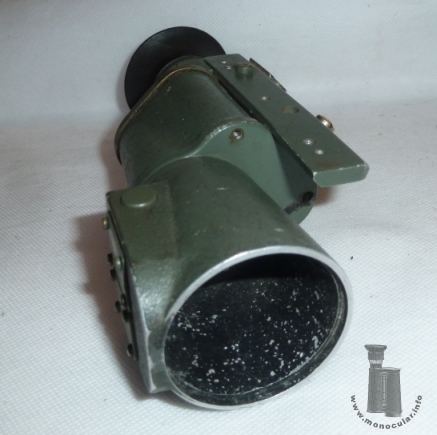
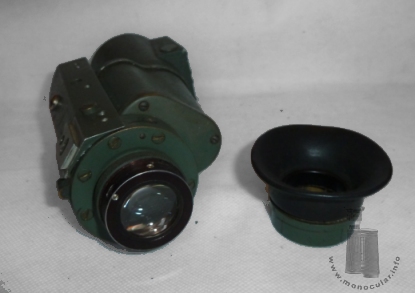
Fotos: Zeun; 1-4, 14 Ebay
